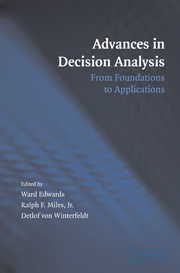Book contents
- Frontmatter
- Contents
- List of Contributors
- Preface
- 1 Introduction
- PART I HISTORY AND FOUNDATIONS OF DECISION ANALYSIS
- PART II STRUCTURING DECISION PROBLEMS
- PART III PROBABILITIES AND BAYES NETS
- PART IV UTILITIES
- 12 Utility and Risk Preferences
- 13 Practical Value Models
- 14 Extensions of the Subjective Expected Utility Model
- PART V RISK ANALYSIS
- PART VI DECISION ANALYSIS IN A BEHAVIORAL AND ORGANIZATIONAL CONTEXT
- PART VII APPLICATIONS OF DECISION ANALYSIS
- Index
- References
14 - Extensions of the Subjective Expected Utility Model
Published online by Cambridge University Press: 05 June 2012
- Frontmatter
- Contents
- List of Contributors
- Preface
- 1 Introduction
- PART I HISTORY AND FOUNDATIONS OF DECISION ANALYSIS
- PART II STRUCTURING DECISION PROBLEMS
- PART III PROBABILITIES AND BAYES NETS
- PART IV UTILITIES
- 12 Utility and Risk Preferences
- 13 Practical Value Models
- 14 Extensions of the Subjective Expected Utility Model
- PART V RISK ANALYSIS
- PART VI DECISION ANALYSIS IN A BEHAVIORAL AND ORGANIZATIONAL CONTEXT
- PART VII APPLICATIONS OF DECISION ANALYSIS
- Index
- References
Summary
ABSTRACT. The subjective expected utility (SEU) model rests on very strong assumptions about the consistency of decision making across a wide range of situations. The descriptive validity of these assumptions has been extensively challenged by behavioral psychologists during the last few decades, and the normative validity of the assumptions has also been reappraised by many statisticians, philosophers, and economists, motivating the development of more general utility theories and decision models. These generalized models are characterized by features such as imprecise probabilities, nonlinearly weighted probabilities, source-dependent risk attitudes, and state-dependent utilities, permitting the pattern of the decision maker's behavior to change with the decision context and to perhaps satisfy the usual SEU assumptions only locally. Recent research in the emerging field of neuroeconomics sheds light on the physiological basis of decision making, the nature of preferences and beliefs, and interpersonal differences in decision competence. These findings do not necessarily invalidate the use of SEU-based decision analysis tools, but they suggest that care needs to be taken to structure preferences and to assess beliefs and risk attitudes in a manner that is appropriate for the decision and also for the decision maker.
The SEU model and its assumptions
The subjective expected utility (SEU) model provides the conceptual and computational framework that is most often used to analyze decisions under uncertainty. In the SEU model, uncertainty about the future is represented by a set of states of the world, which are mutually exclusive and exhaustive events.
Information
- Type
- Chapter
- Information
- Advances in Decision AnalysisFrom Foundations to Applications, pp. 253 - 278Publisher: Cambridge University PressPrint publication year: 2007
References
Accessibility standard: Unknown
Why this information is here
This section outlines the accessibility features of this content - including support for screen readers, full keyboard navigation and high-contrast display options. This may not be relevant for you.Accessibility Information
- 12
- Cited by
